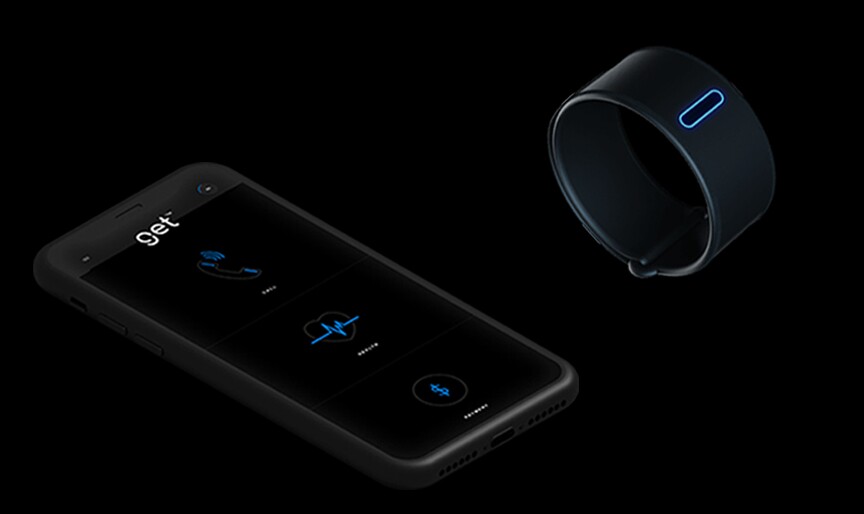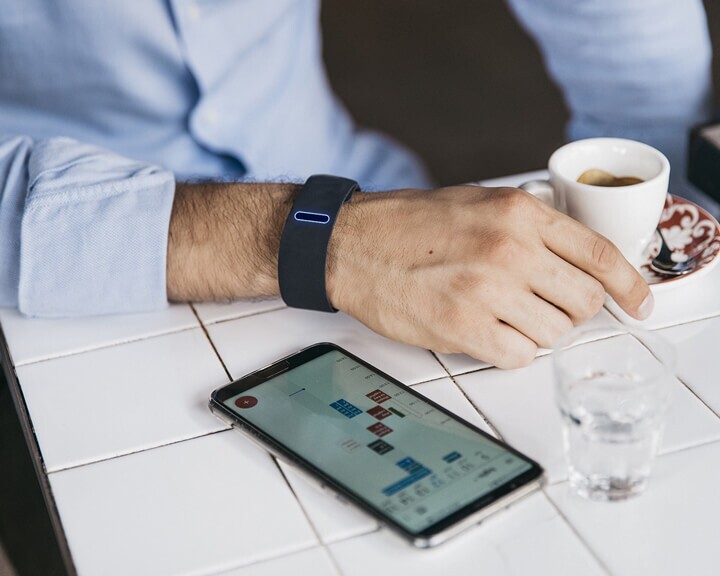It looks like an elegant fitness tracker and acts like a smartwatch, yet it has has no buttons nor a screen. It also plays audio when you touch your finger to your ear and is controlled entirely via customizable gestures and voice commands. It's called Get and its creators think it could change the way we connect with each other and our information.
Get is the brainchild of Edoardo Parini, who first conceived of the product in 2015 as part of his diploma course at the University of Art and Design of Lausanne, Switzerland. Two years later, Parini and his twin brother Emiliano took part in the Innovative Enterprise Incubator of the Polytechnic University of Turin, Italy.
Known as I3P the incubator is ranked as one of the best university incubators worldwide. The twins' company, Deed, came out of this process with a clear vision that Get was a viable product with a strong potential market.

At first glance, it's a little difficult to figure out just what Get all about. This is due to the fact that it looks so simple – and familiar in a FitBit sort of way – and because it does some novel things, none of which are really entirely new. The true cleverness of Get is how the brothers have brought a range of existing wrist-based functionalities together seamlessly, and in a simple, elegant bracelet.
Now, one of the not entirely new things that makes Get so compelling is the ability to listen to phone calls, messages and other audio – in total privacy – without a speaker or headphones. Instead, Get employs bone conduction technology. To listen, all you do is touch your finger to your ear like a futuristic super-spy. The sound is conducted via the Get bracelet, through the bones of your wrist, to your finger tip, which then conducts it directly to your ear's cochlea via your skull.
With this technology, you can hear and make phone calls, have your messages and appointments read out to you, and even listen to music. Okay, this last bit seems a little far fetched, but the team at Deed teamed up with Spotify in April of this year for the launch of the new album by Italian singer Ultimo. At the event, fans listened to the track Colpa delle favole (Blame the Fairytales) via the Get bracelets. So, while it may not be high-fidelity, listening to music – albeit with your finger stuck in your ear – is entirely possible.

The other features of the Get may seem to pale in significance – or at least wow factor – to the bone conduction technology, but when bundled together in one device, they become pretty impressive. Get can track your activity, sleep and biometrics, wake you up for work, give you directions via haptic vibrations on your wrist (one vibration to go right, two to go left) and pay for your latte. And you can use it to talk to Siri, Google Assistant, Alexa and Cortana too.
But as we mentioned before, Get has no buttons, and no screen, so how do we control all these features? With voice and gestures of course. A flick of the wrist one way, and Get tells you the time, a different gesture will answer the phone and another will hang it up. All these gestures are easily customizable and Deed's gesture technology has an open API, so that Get can be used with other devices too, it just needs an idea and someone to implement it.
Now paying for your coffee with a bracelet seems pretty cool, but things get lost and stolen all the time. The brothers have a solution to this too, fingerprint security. When you take Get off, the connection to your precious data and accounts is severed. If someone else picks it up and puts it on, it's just a cool but dumb bracelet. Once the owner puts their Get back on, they touch the fingerprint ID sensor, and they're up and running again.

By the way, you may find there are very few occasions when you might want to take Get off anyway, as it's also waterproof to 10 meters (33 ft). For many users, the only time they might take it off would be to charge it, and since a one-hour charge – via the wireless charge base – lasts five days, that won't be too often either.
All in all the brothers at Deed look like they've addressed a lot of issues that have befallen similar wrist-based projects, and with over 50 awards in the last three years, Get could just become the device that sets the standard for wrist-based smart-tech to come.
The project is raising production funds on Kickstarter. Pledges begin at €110 (US$124) for one Get in a choice of sizes and color, plus the wireless charge base, with shipping starting at €25 ($28). If all goes to plan, delivery is estimated to start in March 2020. A video demonstration can be viewed below.
Source: Get, Kickstarter










